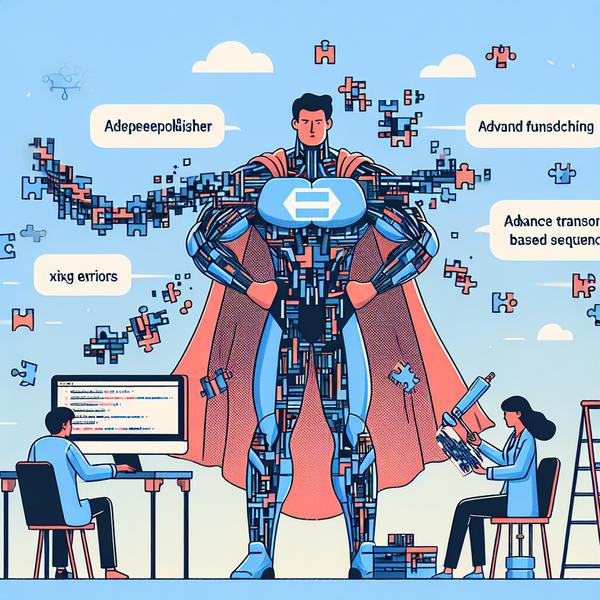
Google AI has recently unveiled DeepPolisher, a transformative open-source deep learning tool that addresses the persistent challenge of genome assembly errors. Created in partnership with the UC Santa Cruz Genomics Institute, this remarkable innovation can enhance genome accuracy by precisely correcting base-level errors. Leveraging advanced transformer-based methods, DeepPolisher demonstrated its incredible efficiency during the Human Pangenome Reference project, significantly reducing sequencing inaccuracies while broadening the scope for genomic research and clinical applications.
Transforming Genomics with Advanced AI Tools
- DeepPolisher is not your typical genome tool. Imagine trying to assemble a massive puzzle—over three billion tiny pieces—and ensuring every single one fits flawlessly. That’s the challenge genome researchers face with sequencing, but even the smallest gaps or misplaced sequences can throw off major analyses. DeepPolisher steps in like a superhero, tackling insertion and deletion (indel) errors, which are the frequent disruptors during annotation.
- This tool uses encoder-only transformer technology borrowed from natural language processing, adapting sophisticated AI to work for genomics. Picture how chatbots understand language structure to predict what you’ll say next. Similarly, DeepPolisher predicts genome errors and corrects them with stunning accuracy.
- Another major highlight? The tool underwent rigorous testing with human cell line data verified by organizations like NIST. Achieving accuracy levels as high as 99.99999% isn’t just impressive—it’s groundbreaking. If you didn’t like math before, now you might, seeing how these digits translate into fewer errors.
How DeepPolisher Works: A Simple Walkthrough
- DeepPolisher’s workflow is like carefully stitching together a complex fabric. Everything starts with input alignment—this means matching genome sequencing reads (taken using tools like PacBio HiFi) to a haplotype-resolved genome assembly.
- Using advanced tech, DeepPolisher scans individual 25kb genome windows and pinpoints where mismatch errors are hiding. It's like searching for typos in a very long essay, except here, the stakes are a lot higher.
- Next, these small error-prone regions are “encoded” into multi-channel tensor formats. Think of them as color-coded puzzle pieces carrying a ton of technical information, like mapping qualities and base qualities.
- The final touch comes when the transformer-based model processes these tensors, predicts the correction, and outputs an error-free polished genomic sequence. Imagine running a spell-checker, but one that actually rewrites the story better!
Performance Achievements of DeepPolisher
- If we compare genome assembly to building a skyscraper, accurate sequencing is like laying down perfectly straight beams. With DeepPolisher, that margin for error shrinks exponentially. For instance, indel errors saw a whopping >70% reduction, leading to even greater reliability.
- When tested with the Human Pangenome Reference Consortium (HPRC), DeepPolisher achieved an error rate as low as one error per 500,000 bases. That’s like finding only one misplaced letter in 10 lengthy books combined!
- DeepPolisher also significantly improved Q-scores (a mark for sequencing quality). Raising it from Q66.7 to Q70.1 means a jump from excellent to exceptional, tying directly into better research insights and health breakthroughs.
Why Open Source Matters: Broad Benefits
- DeepPolisher being open-source is like a gift that keeps giving. Available on GitHub, it empowers researchers everywhere to replicate its workflow without being locked behind corporate barriers. Imagine a top-notch recipe going public for every aspiring chef worldwide.
- The platform offers detailed tutorials for users, so whether you’re new or experienced in genome assemblies, it provides step-by-step guidance (including Dockerized workflows) that simplifies otherwise intimidating tasks.
- Researchers in agriculture, medicine, and even historical genomic studies can adapt DeepPolisher for various organisms. It’s like scaling up a tool kit that can fix not just houses but skyscrapers, automobiles, and everything else!
Future Directions: The Unbounded Potential of Genome Research
- DeepPolisher isn’t just a success story—it’s a leap into new frontiers. Future genome projects could achieve near-perfect sequencing accuracy, unlocking potential for disease research and population studies previously constrained by errors.
- Imagine researchers tracking rare genetic variants that unlock answers for diseases like cancer or personalized medicine. DeepPolisher contributes by ensuring their references remain fault-free.
- Moreover, this innovation brings us closer to next-generation tools that will allow sequencing projects for other organisms at an accelerated pace, fostering ecosystems of scientific breakthroughs across microbiology, botany, and more.
Conclusion
DeepPolisher exemplifies the harmony of cutting-edge deep learning methodologies with the intricate world of genomics. By drastically improving error rates and streamlining processes, it paves the way for a new era in genome research—pushing boundaries in health diagnostics, population genetics, and beyond. With a reliable, open-source approach, it serves as a cornerstone for global scientific advancement.